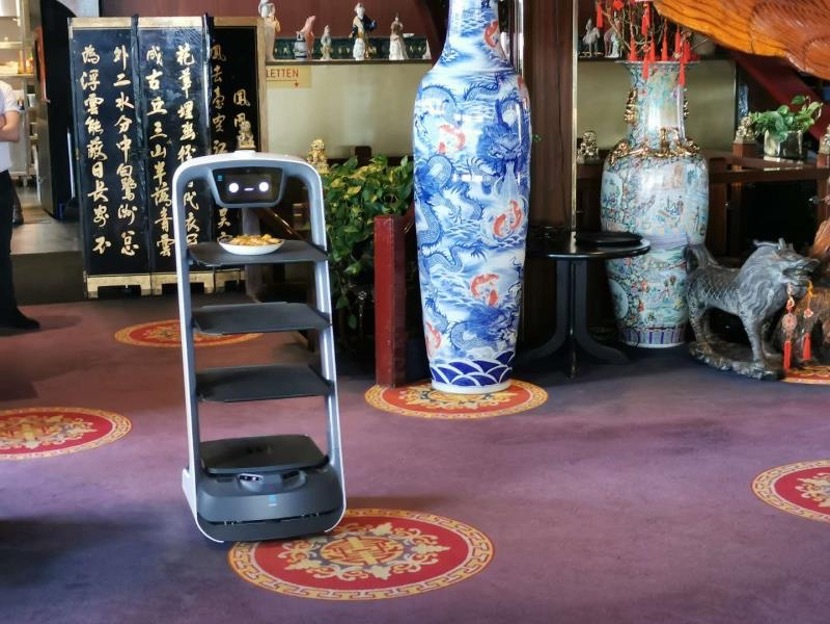Welcome to what is supposed to be my first attempt to create what people might call a blog post. Since this is the first time ever that I am trying myself on ‘creative writing‘, give it a go and bear with me and we will see together in which direction this blog will go. This is however not the topic of this post for that might be a little bit too simple and not related to digital media after all.
Digital restaurants
It is fair to say that the average person is able to use smartphones, laptops or tablets as they are part of our modern, everyday lives. We encounter them in almost every part of our lives without ever questioning their existence in any sector of society, let it be education, transportation, hobbies, etc. But now they also entered a space where there is absolutely no need for these digital devices: the food and restaurant branch. This is strange, right? Why do we need digital devices to help us eat and drink and where is the sense in that? This digitalization of restaurants and cafes somehow decreases the natural aspect of something as simple as eating and drinking and reduces the social interactions between people.
A strange first encounter
The first time I got in touch with these hyper modern and digitalized restaurants was a few years ago in Germany. The city next to my hometown had this newly opened Japanese sushi all-you-can-eat restaurant called Oishii. We went in there with a group of five, were led to our table and handed a Samsung tablet. The waiter explained to us that we would have to order the food through this tablet and only then the food would be brought to our table. A little bit skeptical, we did as we were told and ordered our first round from the all-you-can-eat menu through the tablet. So far so good. The waiter brought the food and drinks we clicked on and we started to rapidly eating our little snacks and sushi. However, when we wanted to order the second round of food, the tablet got in our way. Apparently, we could only order every 15 minutes, so the tablet was blocked for ordering again. This was not really a nice first experience with a semi-digitalized restaurant for our hungry group.
Consequently, we sat there, hangry that we had to wait another 5 minutes (yes, I know other people don’t even have the luxury of having food on demand) until we could order again, which would definitely not have happened if we could just call a waiter to pick up the order in the classic style. Anyway, we didn’t have another choice but to submit to the system to get our impatiently desired food.
Déjà-vu: Dinner with a robot
By now (2021) everyone is used to scanning QR-codes, ordering at UberEats or Thuisbezorgd or in an actual restaurant through tablets and therefore having as little human interaction as possible. What I experienced two weeks ago though, is really the cherry on the icing.
I was invited to a family dinner in Amsterdam. Thus, we went to this floating Chinese restaurant right next to the central station in Amsterdam called sea palace restaurant. Just like in other restaurants we were asked by the waiter if we would like some drinks first and after receiving our drinks, we scanned the QR-code on the table and ordered the food on our smartphones. Nothing unusual yet, right? We all have been doing this before, especially now in Covid-19 times (where human contact and interaction additionally became less).
But now, ladies and gentlemen, comes the interesting part.
Instead of a human waiter, a little robot on wheels with a little smiley face brought the food to our table.

I was really perplex for the first few seconds, since I certainly did not expect this. So not only do we order online on our phones, but on top of that we are also denied a human waiter. The only interaction we had was with the waiter when he delivered the drinks. It felt like the restaurant owners did not want to communicate and interact with their guests at all or just wanted to us to eat, pay and leave as soon as possible so they can make more money with the next guests.
All these digital devices, artificial intelligences and other media are for sure practical, especially now when social distancing became a big thing or when it comes to efficiency and the ever-increasing tempo of our society. But they just can’t keep up with the good old face-to-face encounters and interpersonal relationships which you experience with other people. Isn’t it refreshing when you can have a good conversation with an employee, crack some jokes or be angry at them when they spill a drink over your jeans? (Preferably not the last one, even though you would have a funny story to tell later on)
Indisputably, we had a great time at the restaurant with good conversations and good non-digital food. Sooner or later we will see more of these digitalized restaurants, maybe in different forms, as they are the result of our developing society. So I guess my conclusion is that food-robots creep me out a little, but I’d still do everything for food and good company so I have to get used to them, eventually.
Additional information:




What an experience! Before reading your post, I did not know about the fact that robots began to work as waiters in restaurants. It is such an efficient way of managing a restaurant I may say, and maybe even a cheaper one if we are looking from the owner’s perspective. They don’t have to pay for the salaries of waiters, robots are much cheaper and easier to take care of. They don’t need health insurance either 😉 Until here it is indeed perfect. But, being welcomed by a person once entered a restaurant, having a little conversation, asking what their favorite food on the menu is… These aspects are our needs as humans for communication, and I feel like these robots would make the whole experience quite “cold” for me. I really like your approach to the topic!